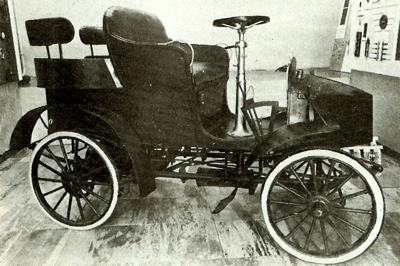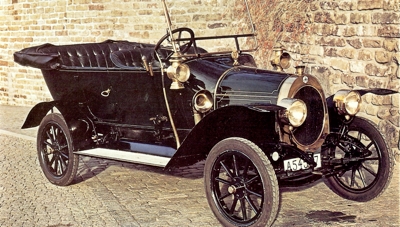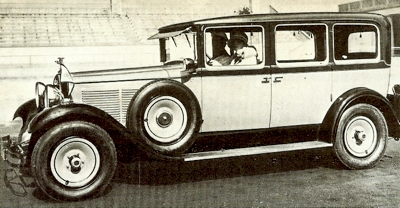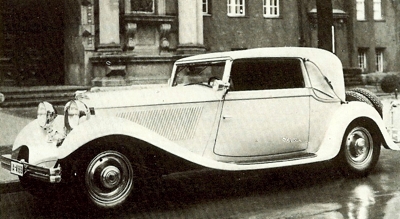Joseph Vollmer's Orient Express
The story of NAG starts at Bergmann's Industriewerke of Gaggenau, Germany, who had created a reputation for themselves as manufacturers of chocolate slot machines and enamel signs. Their first venture into things automotive was designed by Joseph Vollmer, and the company struck upon a great name ... the "Orient Express", but unfortunately the contraption was a disaster. Loosely based on the Benz, it first appeared in 1895, and was soon given the nickname the 'Brute Beast'.
The problem was with the design. The Orient Express had ten hand controls (with the emergency brake on the passenger side) and only one pedal. As you can imagine, it was not all that easy to operate. Disappointed with the lack of success, Joseph Vollmer moved on to the Kuhlstein Wagenbau of Berlin-Charlottenburg, who were just beginning to produce electric vehicles, including
Jeantauds built under licence.
The Kuhlstein-Vollmer Bus
One of Vollmer's first designs for Kuhlstein Wagenbau was a huge electric mail-coach, the Kuhlstein-Vollmer bus, but Vollmer had his heart set on the design of automobiles, and by 1899 the company was manufacturing petrol avant train powerpacks. These converted horsedrawn vehicles by replacing the front axle with what appeared to be the rear end of a Benz Velo.
When the big electrical company AlIgemeine Elektrizitats-Gesellschaft decided to expand its car-building activities and acquired Kuhlstein in 1902, it was the coach-building side of the business which was its main interest. However, the egregious Herr VolImer was retained as designer, and produced two models for AEG, which now renamed its motor-manufacturing division Neue Automobil-GeselIschaft (New Motor Company).
Neue Automobil-GeselIschaft
The new cars were the twin-cylinder Type A and the 5.2 liter Type B, a four-cylinder model on Mercedes lines, with chain drive and a four-speed gearbox - very different from the belt-drive machines with which Vollmer had achieved infamy. These first NAGs were conventional re workings of an established design, they seem to have been reliable vehicles and, before long, an enlarged four-cylinder, the Type B2 appeared. It was a big 7.9-liter 40/45 hp model that won the marque its royal patronage in 1907.
Resplendent in the cream, blue and gold livery of the Hohenzollerns of Prussia, it was presented to the Kaiserin Auguste Victoria, who retained her allegiance for NAG despite her husband's fondness for his big Mercedes cars. NAG became an independent company in 1908, when AEG decided to withdraw from car production. They also lost the services of Herr Vollmer, who had joined Lloyd (a subsidiary of the Norddeutscher Lloyd shipping line) at Bremen to design their first petrol car, after two years of building Krieger electrics.
The NAG Puck / Darling
The 1908 season saw a new venture for NAG, a light-four of 1502 cc, which developed 15 bhp and was marketed under the name Puck. A later version was known, in its homeland at least, as the Darling, and enjoyed some minor competition success, thanks to its ability to rev freely up to 3000 rpm. Its most notable achievement was the winning of the Gothenburg Cup in the Swedish Winter Trials of 1912-13-14. By now the marque had achieved a certain sporting cachet, echoed in the agressively ugly Prince Henry-type bodies with their inswept side panels which were available on the larger chassis.
Biggest of all the bewildering array of pre-World War 1 NAGs was the 60 hp, current from 1911 to 1914, which had an 8495 cc engine. Marketed alongside it in the 1912 - 1914 period were the K2 10/12 hp (1502 cc), the 14/20 hp (2085 cc), the Ka 18/22 hp (2597 cc), the K5 20/25 hp (3308 cc) and the 25/35 hp (5193 cc). After the war demand for new cars was somewhat restricted, and NAG concentrated on the C4, a 2½-liter model which was little changed from the old K4, apart from a new vee-radiator in place of the handsome old oval cooler. Even the cruiser-stern Prince Henry coachwork was redolent of 1914.
 1902 NAG Kleingenberg. It was fitted with a 5 hp single-cylinder engine.
1902 NAG Kleingenberg. It was fitted with a 5 hp single-cylinder engine.
 1912 NAG K2 phaeton. Its nickname was the Darling, and its most notable achievement was winning the Gothenburg Cup in the Swedish Winter Trials of 1912-1913-1914.
1912 NAG K2 phaeton. Its nickname was the Darling, and its most notable achievement was winning the Gothenburg Cup in the Swedish Winter Trials of 1912-1913-1914.
 1929 NAG Protos 204. In 1926 the company had merfed with Protos.
1929 NAG Protos 204. In 1926 the company had merfed with Protos.
 1932 NAG 212 Cabriolet, which was fitted with a 4540cc V8 engine, developing over 100bhp.
1932 NAG 212 Cabriolet, which was fitted with a 4540cc V8 engine, developing over 100bhp. |
NAG forms a Consortium with Brennabor, Hansa and Hansa-Lloyd
The German economic climate was so grim after the war that NAG pooled its interests with Brennabor, Hansa and Hansa-Lloyd in a consortium known as the GDA which was aimed at rationalising output and sales so that the constituent makes would not be competing with each other for survival. Instead, each created its own special niche in the market. As far as NAG were concerned, it was a policy that paid off, as it enabled them to retain a strong financial position. They even indulged in a modicum of competition work with the C4b, a lightened sports version of the standard model which had been prepared by Christian Riecken, their chief engineer, who, before the war, had raced for
Minerva.
The Gran Premio della Notte
In 1922, Riecken won a race at the newly opened Berlin Avus track at an average of 84.3 mph (no mean achievement, as the standard for the time was around 70 mph), and better still, the model lost none of the reliability of its stolid parent, as demonstrated in events like the 1923 All-Russian Trials of 1923 and the ADAC Reich Trials of 1923 - 1926, where NAG Cabs were consistently highly placed.
However, the peak of the C4b's achievements came in July 1924 on the Monza autodrome, when Riecken and Hans Berthold covered 1656 miles in 24 hours, an average of 68.99 mph, winning the Gran Premio della Notte. To commemorate this feat, the C4b was re-christened the 'Monza'.
In 1926 NAG acquired the Protos company, builders of the putative winner of the 1908 New York-Paris race, from Siemens-Schuckert, a merger which resulted in a series of dull six-cylinder models marketed ~under the NAG-Protos marque name. A further acquisition followed in 1927, when NAG 1480 bought the Chemnitz-based Presto company (which had itself just absorbed Dux).
The 2.6-liter Presto Type F and the 3-liter Type G were continued as NAG-Prestos after the merger. If there was a message to be obtained from these successive alliances, it was that 'unity is weakness', as the products of the new group were little different from the majority of their contemporaries, drawing much of their styling inspiration from the far side of the Atlantic.
NAG hire Paul Henze
However well made they were, they were not distinctive enough to attract new customers, and NAG sales plummeted. In an attempt to reverse the trend, they built a straight-eight prototype, but this proved to be such a disaster that it never went into production. Instead, NAG hired one of Germany's most gifted car designers, Paul Henze, who had graduated through Cudell and Imperia to the Simson-Supra and Steiger sports cars, to create a new luxury model. He decided to opt for a V8 layout, to avoid the problems of excessive engine length and crankshaft whip that had caused the abandonment of the straight-eight.
The First German V8 to Achieve Production Status
The 4540 cc NAG unit was the first German V8 to achieve production status and, mounted in a rigid cross-braced frame, it created one of the outstanding German luxury cars of 1931, the NAG 212. But in all that frenzied merging at the end of the 1920S, NAG had swallowed up the tiny Voran company, which had produced a limited number of front-wheel-drive light-cars designed by Richard Bussien.
NAG had already tried devices such as freewheels and centrifugal clutches and now Henze decided to apply Voran's front-wheel drive to the 212. So the V8 was mounted in a fully independently sprung backbone chassis, reminiscent of the Austro-Daimler, and was a combination which promised great things.
However, the concept proved to be way ahead of contemporary engineering capabilities, and the development costs of the handful of prototype fwd V8s proved ruinous. NAG switched to a 1468 cc flat-four fwd model, the NAG-Voran, which appeared in 1933, too late to stave off the end of car production the following year although NAG-Biissing commercials appeared for some time afterwards.
